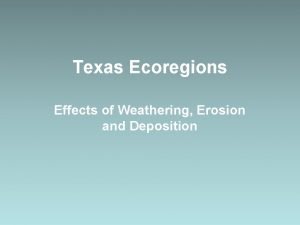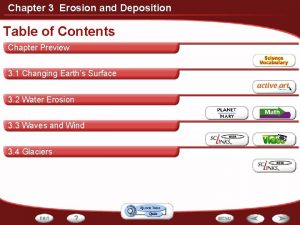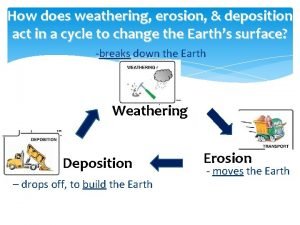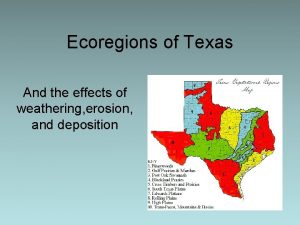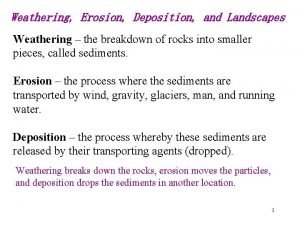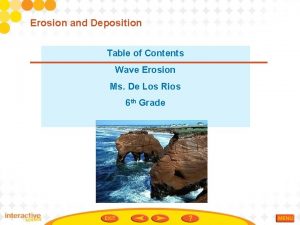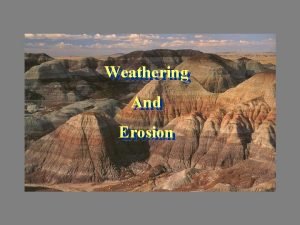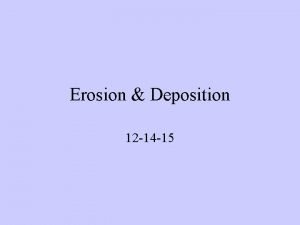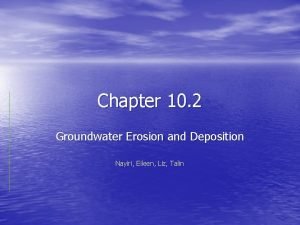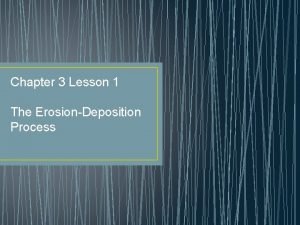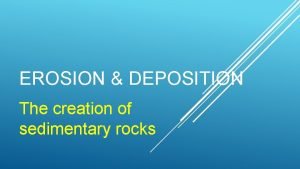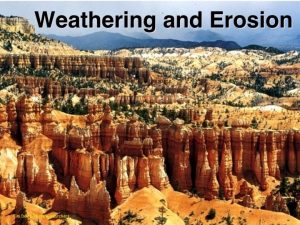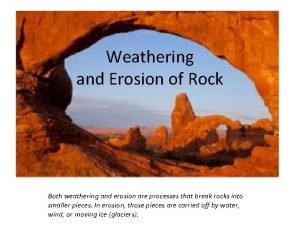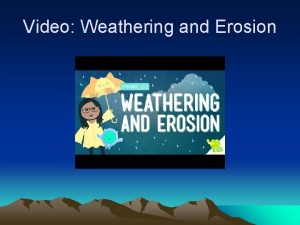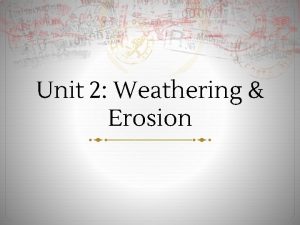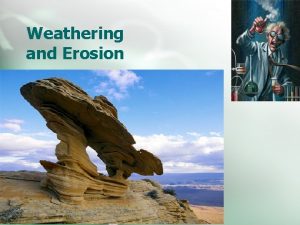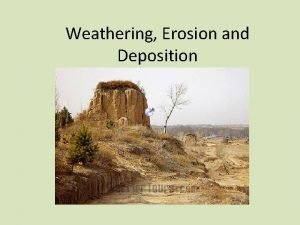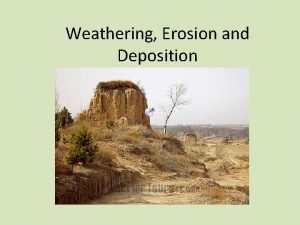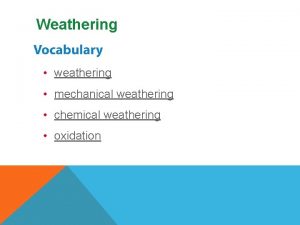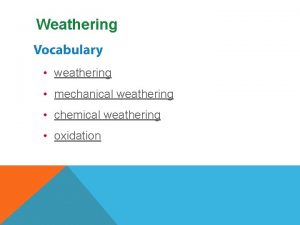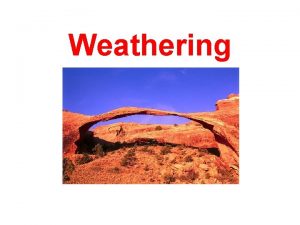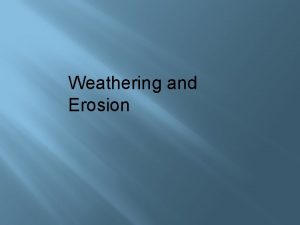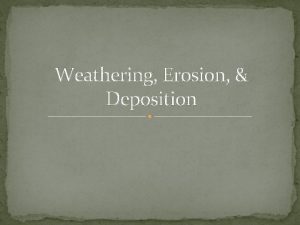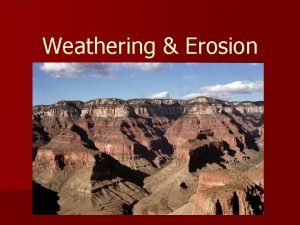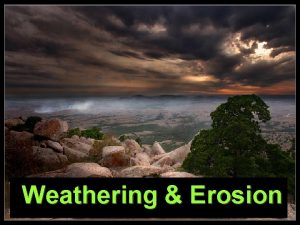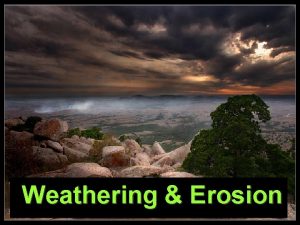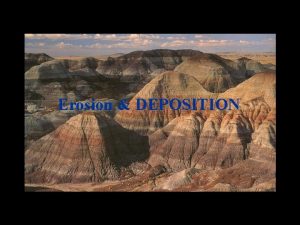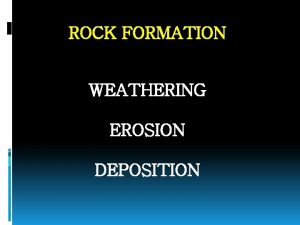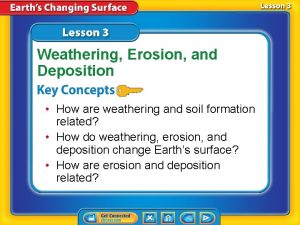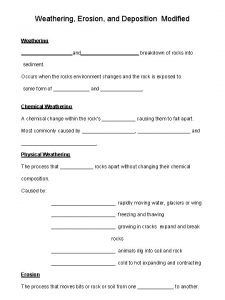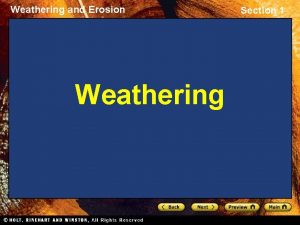Weathering Erosion and Deposition Weathering erosion and deposition




















- Slides: 20

Weathering, Erosion, and Deposition

• Weathering, erosion, and deposition changes the Earth’s surface – Weathering-wears down the Earth’s surface – Erosion-moves the Earth’s surface (acts as a bridge between the weathering and deposition) – Deposition-builds up the earth’s surface

Weathering • Processes at or near Earth’s surface that cause rocks and minerals to break down – Mechanical – Processes that break a rock or mineral into smaller pieces without altering its composition – Chemically breaking down rock into new substances

Types of Mechanical • Abrasion - grinding and wearing down of rock surfaces by other rock or sand particles, usually rounded. Happens by wind, water, and gravity • Ice Wedging – Freezing and expansion of water within rock cracks. • Exfoliation – Peeling back of rock layers

Mechanical Continued • Biotic Weathering – Plants – Send roots into small cracks in rock, the force of the growing roots cracks the rock even more, eventually breaking the rock down. – Animals dig through the soil and move soil particles around, exposing fresh surfaces

Abrasion Wind Abrasion

Ice Wedging

Exfoliation

Biotic Weathering Plant Weathering Animal Weathering

Types of Chemical Weathering • Acid Rain – Precipitation containing acids because of pollution in the air • Oxidation – Chemical reaction in which an element, such as iron, combines with oxygen to form an oxide. Copper Penny • Acid in Ground Water – Some water contains weak acids which over long periods of time dissolve rock forming large caverns (not all caverns)

Acid Rain The rock at Moon Valley has been worn away unevenly by decades of acid rain

Oxidation

Acid in groundwater

Erosion • Erosion is simply movement down a slope due to gravity. We call it erosion if the rock particle is moved by some flowing agent such as air, water or ice. • Erosion creates Valleys, Plateaus, Saddles • So, here it is: if a particle is loosened, chemically or mechanically, but stays put, call it weathering. Once the particle starts moving, call it erosion.

Glaciers

Water Galveston before and after IKE

Wind

Deposition • The process of eroded earth materials (sediments) being deposited in a new location – Ex: delta-where sediment is deposited where a river flows into an ocean or lake builds up a landform 1. Ex: sand dune-a deposit of wind blown sand

Delta’s

Sand Dunes
 Trans pecos weathering
Trans pecos weathering Post oak savannah weathering erosion and deposition
Post oak savannah weathering erosion and deposition High plains deposition
High plains deposition Weathering erosion and deposition
Weathering erosion and deposition Grade 2 science worksheets
Grade 2 science worksheets Gulf coast prairies and marshes erosion
Gulf coast prairies and marshes erosion Agents of soil erosion
Agents of soil erosion An area of wave-washed sediment along a coast is a(n)
An area of wave-washed sediment along a coast is a(n) A tiny groove in soil made by flowing water
A tiny groove in soil made by flowing water Difference between erosion and deposition
Difference between erosion and deposition Diagram of erosion and deposition
Diagram of erosion and deposition Groundwater erosion and deposition
Groundwater erosion and deposition What is the laying down or settling of eroded material?
What is the laying down or settling of eroded material? Chad lentz
Chad lentz Frost wedging definition
Frost wedging definition Difference between erosion and weathering
Difference between erosion and weathering Waves dropping sand on the beach is an example of what
Waves dropping sand on the beach is an example of what The rock
The rock Hydrolysis weathering
Hydrolysis weathering Weathering and erosion difference youtube video
Weathering and erosion difference youtube video Questions on weathering and erosion
Questions on weathering and erosion

